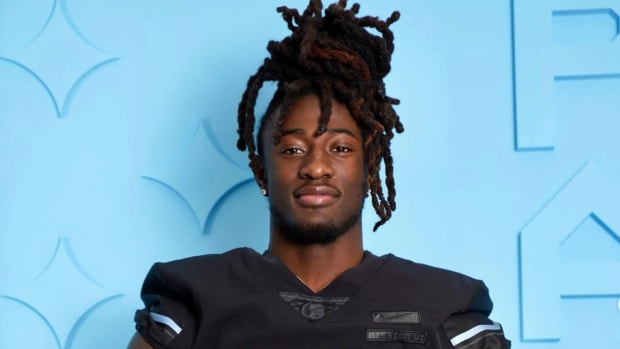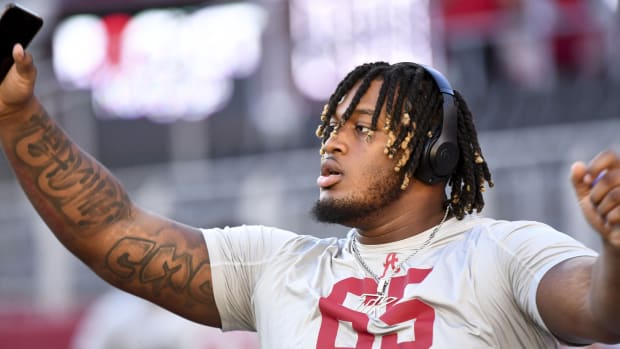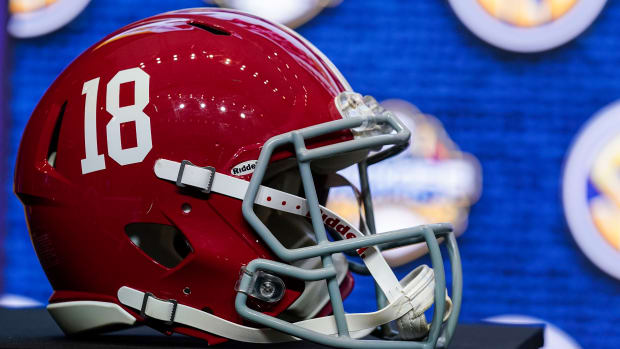
Column: Nate Oats Proved Good Things Can Happen To Alabama Basketball
The once-thought-unbreakable pattern that good things were always followed by bad things when it comes to Alabama basketball has finally been broken thanks to Nate Oats.
This is an opinion column.
“When good things happen, bad things are sure to follow.”
This was the mantra believed and hopelessly stated by many Alabama basketball fans over the past decade-plus. For me, growing up in Alabama, it’s been the assumption for as long as I’ve been following the sport.
Now, to date myself, I wasn’t around for C.M. Newton’s 1976 squad that lost to Indiana. Nor was I able to witness Wimp Sanderson’s stellar success in the SEC and his steadfast ability to make the Sweet 16. When I was born, Mark Gottfried was the head coach. So while this column may be pandering to a younger audience, these are my experiences having followed Alabama basketball.
Anthony Grant was the new face on the block around the time I started following the sport, and throughout Grant and his successor Avery Johnson’s eras in Tuscaloosa, they were infamous for late-season disappointment.
In Grant’s time, he fielded multiple teams that were arguably NCAA Tournament-worthy, but Selection Sunday was filled with dread year after year. Grant’s 2011 and 2013 teams featured high win totals but were snubbed from the Big Dance. In 2012, Grant got the Crimson Tide to the tournament as a 9-seed, but lost at the hands of a no-call on Trevor Releford’s last-second shot attempt.
Good thing happened, bad thing followed.
After Alabama moved on from Grant, former NBA champion and NBA Coach of the Year Avery Johnson was brought in, and he reinvigorated the program with some excitement. “Buckle Up” was his catchphrase, and it was plastered all over every crimson piece of basketball merch you could find in the Coleman Coliseum concourse.
But three letters defined Johnson’s tenure: N-I-T.
If they released betting odds for NIT berths at the beginning of each year, even getting Alabama as good as +100 from 2016-2019 would have had you laughing all the way to the bank. The Coleman Coliseum event staff might as well have permanently stamped the old (and better) NIT logo on the court to save themselves the trouble of re-adding it every March.
The most frustrating part of the Johnson-era teams was that they always showed promise. You could look up bracketologies any given January and see Alabama around a 9-seed pretty consistently. Those teams were fighting to be in the field, it just had to make it through the most dreaded month for any Alabama basketball fan: February.
The shortest month of the year was the longest for any hoops fan that donned crimson and white in the winter. February collapses became not only feared, but expected among the Crimson Tide faithful.
In four years under Johnson, Alabama totaled a record of 16-16 in the month of February, consistently losing ‘must-win’ games year in and year out. These late-season slides turned into NIT bids, and those NIT bids many times turned into first-round NIT exits.
Good things happened, bad things followed.
So when Alabama pulled the plug on Johnson and athletic director Greg Byrne went out of the box again, hiring a young coach from mid-major Buffalo that had only been head coaching in Division-I basketball for four years, people were nervous, and rightfully so.
The University had gone outside the lines with the last two hires. After Newton, every coach from Sanderson, to Hobbs, to Gottfried all had ties to the University. Why would this hire be any different than the last two?
But different it was.
Nate Oats had success almost immediately. After a first season that goes pretty much forgotten because of the pandemic-canceled postseason, Oats won SEC Coach of the Year in year two. He swept the SEC regular season and tournament championships and got the Crimson Tide to the Sweet 16 as a 2-seed in the NCAA Tournament. That tied its highest seed in school history.
You know how it goes by now though. Alabama finally sees more success than its seen in decades, and its run gets ended prematurely by an 11-seed in overtime.
Good things happen, bad things follow.
That season was followed by Oats’ worst year of his Alabama career, a 6-seed that got upset in the first round of the NCAA Tournament and suffered some of Oats’ worst losses in Tuscaloosa. (Side note, the fact that a 6-seed is the worst of Oats’ tenure so far is unfathomable.)
Then 2023 rolled around, and it looked to be Oats’ magnum opus. Alabama looked unstoppable all season long. It ranked No. 1 in the AP Poll for the first time in 20 years, it swept both SEC titles again, it had the SEC Player of the Year in Brandon Miller, who was also the best American-born prospect in the NBA Draft that year.
Alabama earned the No. 1 overall seed in the tournament and rolled to the second weekend once again. The South Region had beat itself up, leaving an extremely favorable draw standing in the way of Alabama’s best team ever and the program’s first Final Four. Those teams were 5-seed San Diego State, 6-seed Creighton, and 15-seed Princeton. No 2-seed, no 3-seed, no 4-seed. If Alabama was ever going to go to the Final Four this had to be the year. It couldn’t be set up any better.
But what happened? Alabama flamed out in the Sweet 16, again. Worsening its record in the regional semifinal round to 1-9 overall.
Good things happen. Bad things… you get it by now.
Oats’ success through his short Alabama tenure had been unprecedented, but if that team couldn’t make it to the Final Four, could any Alabama team? Was the program cursed, doomed to a never-ending cycle of always coming up short, a bottomless pit of unfulfilled expectations?
The answer to the latter question was a resounding no, against all odds.
Oats had to hit the reset button heading into the 2024 season. All three assistant coaches took head coaching jobs elsewhere, so Oats had to rebuild the staff along with incorporate nine new players onto the roster after a flurry of departures via the transfer portal and the NBA Draft.
The season had a rough start, opening with a 6-5 record albeit against a brutal non-conference schedule. But they turned it around.
Alabama was on fire to start SEC play. The Crimson Tide sat at 11-2 and in first place in the conference as February arrived. Then guard Latrell Wrightsell, who had been integral to Alabama’s mid-season success, suffered a head injury in practice of all places.
Here we go again.
Another late-season slide ensued. Alabama lost four of its last six games, limping into the NCAA Tournament after getting its doors blown off by Florida during its short stay in Nashville for the SEC Tournament. A 4-seed was earned, which in the grand scheme of things was worthy of celebration, especially for program standards. But the general feeling among the fanbase was that this NCAA Tournament run was possibly going to be as short as the stay in Nashville.
There were virtually no signs of life from this team, and Oats’ press conferences post-Nashville consisted of more-or-less begging for defensive effort from his team if they want to win games.
But somehow, someway, they figured it out.
I’m not sure what happened in the days between the final buzzer on March 11 and the opening tip on March 19, but it was transformative.
Alabama opened the tournament with a business-like rout of 13-seed Charleston, setting up a matchup with 12-seed Grand Canyon to go to the Sweet 16. But the Lopes made it a rock fight, and the high-powered offense wasn’t hitting like it normally was.
Grand Canyon took a 3-point lead with less than five minutes to go, had all the momentum, and had a building in Spokane full of students and upset-hungry fans ecstatic at every GCU basket. It’s safe to say probably 90 percent of Alabama teams in the last two decades lose that game, it would have been the Alabama basketball thing to do.
But like they have so many times this season, whether it be against Georgia, or Florida, or Ole Miss, or Arkansas, they found a way when it looked like they weren’t going to.
Fast forward less than a week, and Grant Nelson hit what felt like a dagger three with under four minutes to go against 1-seed North Carolina in the Sweet 16. Alabama was up five with every bit of the momentum. But what happened out of the timeout? Only the most Alabama basketball thing possible: an 8-0 North Carolina run that put the Crimson Tide back down by three points.
A good thing happened, a bad thing followed, and it looked like the end of the season.
Again, we did the same song and dance with this 2024 team that looked like it was going to do what Alabama fans are most accustomed to its basketball teams doing: disappointing. But again, it pulled through.
That’s what made the scene on Saturday night so surreal, as Alabama answered punch after punch to stave off Clemson and at long last advance to the Final Four. The 2024 Alabama basketball team wasn’t supposed to be here. This wasn’t supposed to be the team that finally did it. But there they stood on the stage at midcourt, with matching shirts on and pieces of net tied in their hats, showered by red and white confetti as they hoisted the West Regional championship trophy.
And in the middle of all of them, Nate Oats, now a legend in his own right in Tuscaloosa. The man who defied the odds, and proved that yes, good things can happen to Alabama basketball.




